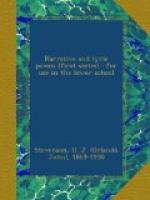[8] Clanis. The modern river Chiana.
[9] Auser. A tributary of the Anio.
[10] Ciminian hill. A lofty mountain in the northern Apennines.
[11] Clitumnus. The river Clitumno.
[12] Volsinian mere. A lake which took its name from the town of Volsinii (modern Bolsena) situated on its banks.
[13] Arretium. Arezzo.
[14] Umbro. A river in Etruria,—the modern Ombrone.
[15] must. new wine.
[16] Written from right to left.
[17] Nurscia. The Etruscan goddess of fortune.
[18] golden shields. Twelve golden shields kept in the temple of Vesta, and believed by the Romans to be bound up with the safety of their city. See notes on pp. 68 and 71.
[19] tale. (A. S. talian, “to reckon".) number.
[20] Sutrium. Sutri, a city about thirty miles from Rome.
[21] Tusculan Mamilius. Tusculum is the modern Frascati, a city about twelve miles from Rome. Mamilius was the son-in-law of Tarquin.
[22] Latium was a province in central Italy, inhabited by the Latins. It was conquered by Rome in the fourth century B.C.
[23] Tarpeian. The Tarpeian Rock was a cliff on one side of the Capitoline Hill in Rome. Tarpeia, from whom the cliff took its name, was the daughter of Tarpeius, the governor of the citadel, on this hill. She betrayed the fortress to the Sabines, but as they entered, they threw their shields upon her and she was crushed to death.
[24] Fathers of the City. The senators.
[25] Crustumerium. A Latin city a few miles from Rome.
[26] Ostia. A city at the mouth of the Tiber, fifteen miles from Rome.
[27] Janiculum. A hill on the right bank of the Tiber.
[28] I wis. See H. S. Grammar, p. 176.
[29] Consul. After the expulsion of the Tarquin kings, Rome was governed by two chief magistrates, known as consuls.
[30] the River-Gate. The gate facing the Janiculum hill.
[31] bridge. The Sublician bridge, which connected Rome with Janiculum.
[32] twelve fair cities. The Etruscan confederacy was composed of twelve cities.
[33] Umbrian. Umbria was a division of Italy.
[34] the Gaul. The Gauls were beginning to invade Italy from the north.
[35] port and vest. Bearing and dress.
[36] Lucumo. Etruscan chief.
[37] roan. A roan horse is of a reddish colour, with white hairs thickly interspersed.
[38] fourfold. With four thicknesses of leather.
[39] Thrasymene. Lake Trasimenus (modern Lake of Perugia). It is only about twenty feet deep.
[40] holy maidens. The vestal virgins, whose duty it was to keep the fire burning on the altar in the temple of Vesta. Vesta was the goddess of the home, and the vestal virgins were bound by oath never to marry.




